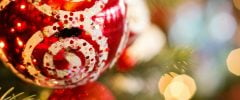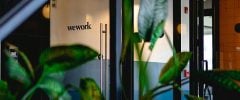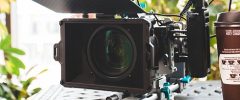The Pros and Cons of Fiberglass Planters

Fiberglass is a durable and versatile planter material, and though fairly popular, we often encounter a lot of questions about whether fiberglass is the right choice for an installation. To help you decide if these particular containers are right for your plant displays, we answered some of our most frequently asked questions and put together a list of pros and cons of fiberglass planters.
How are fiberglass planters made?
Fiberglass planters are made by layering sheets of interwoven glass fibers into a mold with resin. Once the resin hardens, the planter is removed from the mold and is then sanded and finished with automotive-grade paint. After the paint dries, it’s ready to ship!
How to Spot Low-Quality Fiberglass Planters
Though the process of making fiberglass planters seems straightforward, some vendors may cut corners to reduce costs, compromising planter quality. Over time, low-quality planters can look worn, and the shortcuts become more apparent. This is why it’s important to source planters from companies that specialize in fiberglass planters and fully commit to the finishing process.
Here are key signs of a low-quality fiberglass planter:
- Excessive weight: If a fiberglass planter feels unusually heavy, the manufacturer likely added fillers to the resin.
- Rough surface: Bumps, waves, or imperfections in the finish often suggest poor construction or rushed work.
- Chipping or flaking paint: Poor-quality paint or a rushed finishing process can cause paint to chip or flake off, exposing the underlying fiberglass to potential damage.
- Visible seams: If seams are visible or poorly finished, it’s often a sign of inadequate craftsmanship. High-quality fiberglass planters should have smooth, seamless construction.
Fiberglass Planter Pros
Fiberglass planters offer numerous benefits that make them a top choice for professional interiorscapers. Their durability, versatility, and aesthetic appeal make them suitable for a wide range of installations. Below, we’ve highlighted some of the key advantages of using fiberglass planters to enhance your designs and meet the demands of various environments.
Indoor and Outdoor Usage
Fiberglass planters are built to perform in both indoor and outdoor spaces. Outdoors, they can withstand all weather conditions—rain, snow, sleet, and intense sunlight—without wear or discoloration, thanks to automotive-grade finishes that protect against UV rays and the elements. Most outdoor fiberglass planters also include drainage holes to prevent water buildup and reduce the risk of cracking caused by freezing water.
For indoor usage, the same durable finish offers protection against wear from foot traffic and natural oils from curious hands. Since drainage holes aren’t typically necessary for indoor use, interiorscapers often choose to keep planters sealed to retain moisture and help protect client floors.
Lightweight Construction
Compared to stone, concrete, ceramic, and terracotta planters, fiberglass pots are incredibly lightweight. The combination of fiberglass fibers and resin, when properly balanced, creates a planter structure that is strong but easy to move, even in larger sizes. This lightweight advantage simplifies installation and allows for greater flexibility when designing or relocating plant displays, especially in large commercial spaces or areas that require frequent changes.
Low Maintenance
Fiberglass planters require very little maintenance. You can leave them unattended in both indoor and outdoor conditions for extended periods without diminishing their appeal or functionality. However, to maintain their best appearance, occasional cleaning and application of wax can help the planter continue to look polished and professional in any setting. This minimal upkeep offers a key advantage for installations with limited time and maintenance resources.
Long-Lasting Durability
Fiberglass planters are made to last. Whether placed indoors or out, these planters endure adverse weather, heavy foot traffic, and prolonged exposure to UV rays, all while maintaining an attractive foundation for plant designs.
Custom Color Options
Fiberglass planters come in a wide selection of standard colors, allowing you to match most interior or exterior designs. Some companies offer custom-painted options for projects requiring a specific color scheme, tailored to match a RAL color code. This flexibility in color selection makes fiberglass planters a versatile choice for professionals looking to achieve precise visual harmony in their installations.
Fiberglass Planter Cons
While fiberglass planters offer many advantages, it’s important to consider any potential drawbacks before making an investment. Though the benefits far outweigh the drawbacks, understanding this will help you make a more informed decision about whether fiberglass planters are right for your projects. Below is a key consideration to keep in mind.
Initial Price
The upfront cost is the main con of fiberglass planters. They tend to be a pricier choice, especially when compared to plastic planters. However, the long-term durability of fiberglass planters often justifies the investment. While plastic planters tend to crack, break, or fade after one season, fiberglass planters last year after year. Instead of repeatedly spending money to replace plastic planters, a slightly larger investment in fiberglass planters offers a reliable, long-term solution that actually reduces costs over time and ensures a professional appearance for years to come.
Now that we’ve explored the pros and cons of fiberglass planters, it’s clear they are an excellent choice, particularly for their reliability and style. While plants are always the focal point, a well-crafted fiberglass planter serves as the perfect accent for any residential or commercial plant design. As demand for these versatile planters grows, we invite you to explore our extensive selection of sizes, colors, and customization options, perfect for any project.
You May Also Like
Leave a Reply
You must be logged in to post a comment.



















